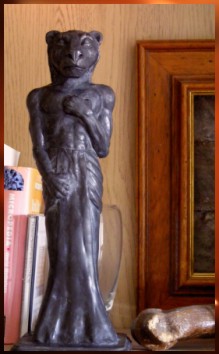About The Artist

Cobweb lives in a little house at the edge of the world with his wife Kt and their cats Sekhmet and Baal. He claims to have been sculpting and painting for as long as he can remember, but it’s been longer than that. He started to make jewellery and produce artwork for bands and nightclubs back in the late eighties. In recent years he has devoted himself more and more to sculpture based around mythical and historical themes, and we’re very pleased to be able to show you the results. His work has appeared on a few walls, some mantle pieces, around the necks of people with exquisite taste, and even made it as far as a book cover. People often ask why he does what he does and how he does it. We’ve managed to persuade him to finally answer those questions.
I’m interested in everything, but you need to start somewhere. Unfortunately for me I started by trying to find out everything that has happened so far. It’s a big subject and I expect to be working on it for a while. Much of my artwork is a way of getting ideas out into the real world because I need more room in my head.
The sculptures usually begin life as words. I’m fascinated by what people have done, but even more by why they did it. I read a lot of books on ancient history and prehistory, and even more on ancient religions and mythology. As a consequence I have a head full of the sort of information that isn’t even useful in a pub quiz. The stories come first and the art comes later. Sometimes I’ll use sculpting as a way of working out why someone made something the way they did, but mostly it’s a way of converting an idea I like into an object I can touch. I’m often amazed at what I learn in the process.

Once something has decided it needs to be made I’ll produce some sketches and usually gather a collection of pictures and photographs that might come in handy. I’ll make a skeleton of sorts, usually out of wire and aluminium foil. It gives me a basic shape and stops things from falling over while I work on them.
Over the bones I use a polymer clay called Super Sculpey. It stays soft until you bake it so you can take your time. For eyes and teeth, and other things which are better kept rigid while I work, I use an epoxy putty. I start with rough shapes and gradually add detail as I go. Often what I have in mind at the start is subject to change several times as the sculpture progresses. They have a way of letting you know what will and won’t work and its best not to fight that too much.

Depending on the complexity of the sculpture it can take anything from a few days to several months before I’m happy. Once I am happy I’ll pop the results in the oven to harden, but I don’t regard what comes out as the finished sculpture. What I’ve made is a master copy for the mould to be taken from, and sometimes it doesn’t survive the mould making process.
Before making the mould the sculpture has to be sealed because Super Sculpey doesn’t get on too well with rubber. I use clear varnish, or spray paints and make the most of the opportunity to add a matt or gloss surface to the sculpture if necessary.
For the moulds I use a brush-on urethane rubber. The mould is built up in layers, with a thickening agent added at certain points, and the process takes about 7 hours. After that a support shell is built up in sections using a plastic paste. This keeps the mould together once it has been split, and prevents any distortion to the final sculpture. When the mould and its outer casing are completed it’s time to try and get the original out in one piece. This involves a very sharp knife, a struggle, and often the application of a few plasters.
I’ve used a lot of different casting materials over the years and I’ve finally found one that I’m happy with, which has the added bonus of not being hazardous to my health. It comes as a synthetic gypsum powder, which is set with a water-based, liquid acrylic. The addition of pigments and textural additives allow for a range of finishes from stone to ivory.
Once removed from the mould the sculpture needs a few finishing touches, and is then given a stain to bring out the fine detail before polishing. I treat the process from casting to polishing as one action. It is the creation of what I regard as the final sculpture.
While multiple casts can be made from the same mould, I decide on the number to be cast beforehand, and once that number is reached there will be no more. The numbers may seem random but each one has a meaning for me that ties in with the ideas expressed in the artwork. This is done using a system known as gematria where words or phrases are given a numerical equivalent.
Every cast is an original. The processes involved ensure that no two will ever be exactly alike, and as much love and care goes into every one.
My main concern with the sculptures made for Eolith Designs was that they didn’t just look right, but felt right too. They needed to have the right weight, the right texture, and feel the right temperature when you touched them. After many months of experimenting I’ve been very pleased with the results.

All images and text © Eolith designs. Do not reproduce without written permission.
 Project part financed by the
European Union
Project part financed by the
European UnionEuropean Regional Development Fund 2007-13
